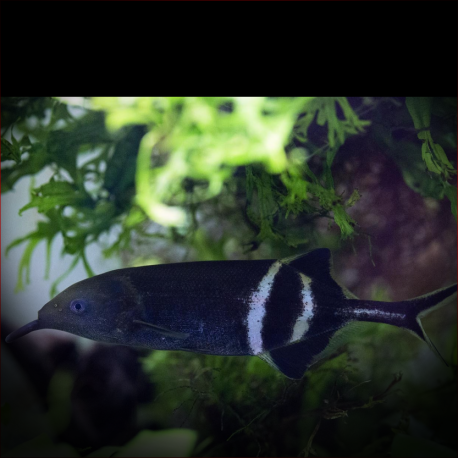More info
Datasheet
| Minimum Tank Size | 255 litres / 67.36 US gallons |
| Maximum Size | 22.5cm / 8.86inches |
| Temperature | 23°C / 73.40°F - 28°C / 82.40°F |
| Hardness | 5-15ºdH |
| pH | 6.0-7.5 |
General Description
The Elephantnose Fish, scientifically known as Gnathonemus Petersii, is a popular Mormyrid species in the aquarium trade, recognized for its peculiar trunk-like protrusion that aids in feeding. This scaleless fish requires specific care due to its sensitivity to bright lighting and medication commonly used in aquariums.
Aquarium Setup
A minimum tank size of 255 liters is recommended for Elephantnose Fish, with dim lighting to mimic its natural habitat. To support their burrowing behavior, a sand substrate is essential, while providing hiding spots with smooth rocks, driftwood, and plants such as Anubias sp. and java fern is beneficial.
Behaviour
Although peaceful towards other species, the Elephantnose Fish can be territorial, hence it is advisable to avoid keeping it with overly active or aggressive tankmates. Conspecifics should be introduced in groups of at least five to disperse aggression, as solitary or pairs often lead to bullying and aggression among them.
Feeding and Diet
Elephantnose Fish are unfussy eaters, accepting various dried, frozen, and live foods; however, worms are a particular favorite. This nocturnal species relies on its sensitive electrical field to locate food, emphasizing the need for dim lighting in the tank.
Reproduction & Dimorphism
Reproduction of Gnathonemus Petersii in captivity is challenging, attributed to the disruption of their electric communication patterns in confined aquarium settings. Sexual dimorphism is not externally evident, but can be distinguished by examining the electric fields produced by the fish, which is impractical for standard aquarists.
Habitat and Distribution
In the wild, the Elephantnose Fish inhabits dark, muddy riverbeds with slow water flow and abundant vegetation. Its distribution spans across countries such as Mali, Nigeria, Zambia, and the Republic of Congo, where it thrives in similar riverine environments.
The unique sensory adaptations, sensitive nature, and specialized care requirements of the Elephantnose Fish make it an intriguing addition to well-maintained aquariums.

